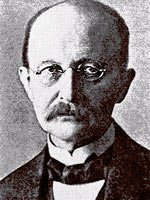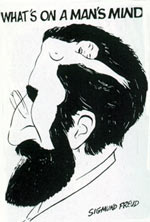
In the year 1900
there was a flowering of genius in practically every sphere of human activity;
Paris and Vienna are often singled out as housing major explosions
of brilliance as the twentieth century began, but there were great
achievements throughout the world.
In this issue, Shebang picks out just two of that period's
most influential people, whose works were made public one
hundred years ago:
Max Planck and Sigmund Freud.
Max Planck coined the term 'quantum', and provoked a scientific upheaval that he himself grew to regret. On the 19th of October 1900, he announced a new formula at a meeting of the Berlin Physical Society; his calculations were based on the fact that as objects became hoter or colder, the changes in energy occurred in (exceedingly small) bursts or jumps; quanta.
The title page of Sigmund Freud's book 'Die Traumdeutung' - 'The Interpretation of Dreams' - declares that it was published in 1900. In fact it was published on November 4th 1999, but his rather large volume is a quintessential 20th century book.
Max Planck
Born Kiel, Germany April 23 1858 - Died unknown, USA, October
4 1947
In 1874, young Max Planck entered the University of Munich. Before he began his studies he discussed the prospects of research in physics with Philipp von Jolly, the professor of physics there. Oddly enough the professor warned him off his own subject. In fact, von Jolly told Planck that physics was essentially a complete science with little prospect of further developments.
By the time he was thirty-two he found himself telling people that he identified somewhat with Newton; he was on the threshold of a major discovery. What Planck, a most conservative and regular person, did not realise, and later grew to regret, was that he had ushered in what has been called 'the most revolutionary idea which has ever shaken physics.'
The way he did it was to introduce a cheat into the mathematics, which, after a great deal of work and thought, he realised was Nature's cheat.
In 1897 Planck began work on a problem which later came to be called 'the ultraviolet catastrophe'. Most people will know what a 'red hot poker' is, or will have seen a glowing red coil on an electric cooker. In fact metals can get a great deal hotter than red hot, and as the heat inside them becomes more and more intense, their colour will change, going through the 'spectrum' - from red via orange and blue, all the way to white and ultra-violet.
If the absorption and emission of this radiation were to take place in a continuous progression, the energy involved would be unbounded, and at the ultraviolet level would be cataclysmic. This did not happen in nature, and it made no sense in scientific terms, given what was known at then, which Planck continued for some time to trust.
In a way he solved the problem in a back-to-front fashion, by working with the mathematics involved. Of all the attempts to calculate what was going on, there was one partly successful idea proposed by the German physicist Wien for radiation at the lower-frequency, or infra red level, and one by the Englishman Lord Rayleigh, which dealt with the high frequency, ultra-violet region.
Planck saw a logical way of combining the best features of those two mathematical expressions, and presented that formula to his colleagues. The agreement between his calculations and experimental results was excellent, but no-one had a clue what they might mean.
Still expecting that as black objects were heated, their energy changes would flow smoothly, Planck looked again and again at the figures.
For the sake of the calculations, he was forced to consider a hypothesis which broke drastically with 19th century physics. As he later said: '....the whole procedure was an act of despair because a theoretical interpretation had to be found at any price, no matter how high that might be.'
He considered the possibility that in black body radiation, the energy changes in bursts or jumps. These were later called 'leaps', and they are extremely small.
[The number involved is .000 000 000 000 000 000 000 00 0066 erg seconds. . This is usually expressed as 6.6 X 10-27 erg seconds. Planck assigned to that number the letter h, so that E -or energy - is equal to h times the frequency, or E=hf]
By the end of 1900 Planck had more or less completed a theoretical deduction of his formula renouncing classical physics and introducing the quanta of energy. At first the theory met with resistance but due to the successful work of Niels Bohr in 1913, calculating positions of spectral lines using the theory, it became generally accepted.
Planck received the Nobel Prize for Physics in 1918. Despite having invented quantum theory Plank did not understand it himself at first. What's more, it pained him throughout his life that the idea for which he was most famous had given the world quantum theory and quantum mechanics; they contained notions which troubled him deeply.
' I tried immediately to weld the elementary quantum of action somehow into the framework of classical theory. But in the face of all such attempts this constant showed itself to be obdurate ... My futile attempts to put the elementary quantum of action into the classical theory continued for a number of years and they cost me a great deal of effort.'
Biographical note: Max Planck remained in Germany during World War II. Throughout his life, war would cause him deep personal sorrow. (The same was true of Freud) Planck lost his eldest son during World War I. In World War II, his house in Berlin was burned down in an air raid. In 1945 his other son [Erwin] was executed when declared guilty of complicity in a plot to kill Hitler.
Sigmund Freud
Born Pribor, Moravia, May 6, 1956. Died London, September 23 1939
From the earliest times, people have dreamed, and told their dreams, and have believed that dreams will make you better. And yet it has justly been said that Freud's book 'The Interpretation of Dreams' is one of the most significant books of the last 20th Century.
Sigmund Freud has
been lavished with praise and castigated, honoured and reviled, rejected
and rehabilitated many times.
Ridiculed throughout his life, he found it extremely difficult to be heard
- and once heard, his work has always been under attack.
He has received particularly rough treatment at the hands of feminists.
And yet there are women writers such as Juliet Mitchell
who appear - at least to an extent - to defend him.
Freud poured into 'The Interpretation of Dreams' the distillation of twenty years' work and thought, and a great deal of experience with patients. He also had to employ a large measure of self-analysis.
The book markes the beginning of new ways of understanding the mind. It is certainly the start of the theory of a dynamic unconscious, created in childhood, which is operating continuously in both normal and 'abnormal' minds.
Freud called the interpretation of dreams the 'Royal road' to the discovery of the unconscious - that is to say, it is the 'King's highway' along which everyone can travel to discover the truth of unconscious processes for themselves. Everybody dreams.
The argument in Freud's book The Interpretation of Dreams goes something
like this:
(1) "Dreams are the
fulfilment of a wish"
(2) "Dreams
are the disguised fulfilment of a wish"
(3) "Dreams
are the disguised fulfilment of a repressed wish"
(4) "Dreams
are the disguised fulfilment of a repressed, infantile wish"
While
current work in neuroscience is leading to discoveries in brain function,
past work has led to better understanding of the brain as chemistry. This
work, which was presaged
by Freud when he tried to integrate his observation of dreaming with the
biology of his time, has led to breakthroughs in drug
therapies for many mental illnesses including manic-depressive illness,
depression, schizophrenia, and psychosis.
The line where the brain and behavior meet is also now the focus of much of modern neuroscience. And dreams are proving to be a foundation for much of that research. After a brief period when dreams were thought to be little more than mental fireworks, scientists are finding that they provide many insights into the mind's workings. Modern scientists, using technology such as PET scans are discovering that Freud's "road" is indeed "royal."
Freud in a letter from Schloss Bellevue. 'Life at Bellevue is turning out very pleasantly for everyone. Do you suppose that some day a marble tablet will be placed on the house, inscribed with these words: "In this house on July 24th 1895 the Secret of Dreams was revealed to Dr. Sigmund Freud"?'
Freud again: '...if I was to report my own dreams, it inevitably followed that I should have to reveal to the public gaze more of the intimacies of my mental life than I liked, or than is normally necessary for a man of scince and not a poet. Such was the painful but unavoidable necessity; and I have submitted to it rather that totally abandon the possibility of giving the evidence from my psychological findings." The Interpretation of Dreams.
The book had a 'powerful subjective meaning' for Freud, which he had been 'able to understand only after its completion'.


